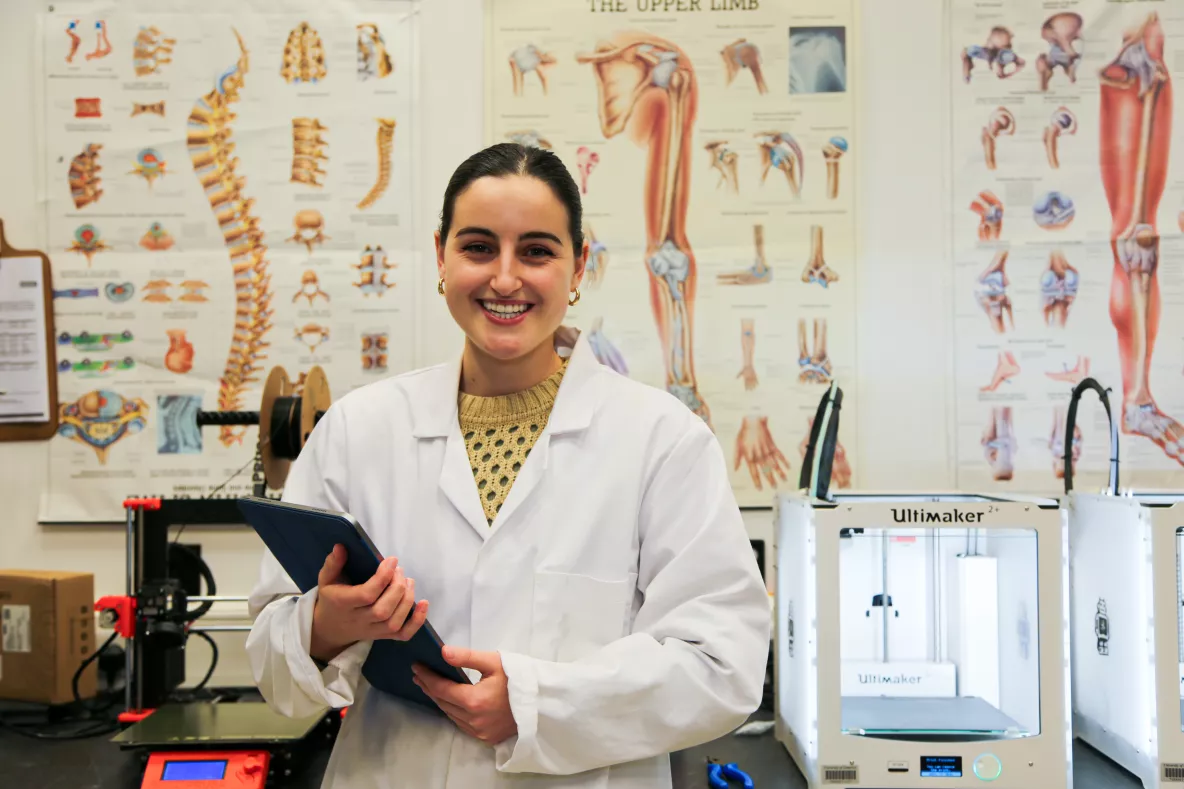

Gráinne Tyrrell is a PhD student in the School of Architecture and Product Design in the Faculty of Science and Engineering at the University of Limerick. Her PhD is being co-funded by industry partners Medtronic through the Irish Research Council’s (IRC) Enterprise Partnership Scheme.
Gráinne’s research aims to improve the design of the devices used during the Transcatheter Aortic Valve Implantation or ‘TAVI’ medical procedure. This is a minimally invasive procedure during which a patient’s diseased native aortic valve in their heart is replaced by a prosthetic implant (a stent). In order to get to the patient's heart, delivery catheters are inserted via the groin (or another suitable vessel) and tracked through the vasculature to the aortic arch. By manipulating the handle of the delivery device, the stent is deployed at the distal end of the delivery system allowing the patient to return to good health. This is a common but complicated procedure, Gráinne explains:
“TAVI devices prompt physicians to perform highly complex grasps and movements to achieve an array of actions. I have been observing and assessing TAVI devices, and how they are used during operations, via in-person and recorded case studies. I have also collected key anthropometric and force data from cardiologists. Collecting the cardiologist's physical hand length and strength impacts how we design the devices and as long as we can design devices that can fit well into their hands and can be operated within their strength, they will find it easier to implant a device at the right depts, place or speed. The size and shape of the device handles dictate the grasp and motion used by the physician. My research aims to gain an understanding of the variables that affect how users interact with device interfaces, allowing for optimised device design to improve the user experience and create better patient outcomes.”
This discipline of focusing on the design of tools and how humans interact with them is known as Human Factors.
“Human Factors (HF) aims to improve design by understanding the capabilities and limitations of the user; for example, in this scenario with medical device design you have your cognitive side – what level of precision you can achieve with a lot of distractions, and your physical capabilities - how strong your grip strength might be, the dexterity of your fingers and so on. HF tools lead to the design of devices that are optimised for user interaction, thus mitigating against errors related to the use of the tool during procedures such as TAVI.”
Improving design can make a real difference in people's lives, especially in the biomedical field, which is one of the reasons Gráinne was drawn to working in this area.
“I love the positive impact that I can link to my research. Working in the biomedical field offers observable quality-of-life improvement to individuals who require cardiovascular interventions. The third most prevalent cause of death in the United States is preventable medical errors. Physicians working in surgeries or interventional procedures are reported to be highly susceptible to work-related musculoskeletal disorders (MSDs), pointing to a disagreement between the physician and the design of their work environment. The implications of increased MSDs and heightened cognitive load are increased patient risk and mortality rates. By dealing with these disagreements between users and their devices, we can not only improve the day-to-day working experience and health of medical professionals, but we can ensure that patients receive the best care possible.”
Gráinne is working with an industry partner through the IRC Enterprise Partner Scheme and this programme emphasises the real-world impact of her research, allowing her to focus on current industry needs.
“I get to regularly engage with cardiologists and discuss their user experiences. Medtronic Structural Heart and Aortic team have helped create links so that I can observe live case studies where patients undergo TAVI procedures. My research is inspired by current industry needs. Working with an industry partner means that I gain invaluable insight into the requirements of R&D engineers during the product development process. A key aspect of my research is ensuring engineers have the right anthropometric data and Human Factors tools available to them when developing new devices.”
This interaction with professionals working in the field is something that Gráinne really enjoys.
“Meeting a variety of researchers, cardiologists and key opinion leaders in the biomedical industry can be so invaluable. It generates new ideas, establishes new network links, and can help combat imposter syndrome. It is inspiring to hear about others’ journeys and helps me to appreciate that we all have vastly diverse career experiences.”
Gráinne’s journey to her PhD began during the BSc in Product Design and Technology at UL. Her final year project introduced her to the design of medical devices, and she got to present at an annual design exhibition held by the School of Architecture and Product Design. This was a proud moment for her and her family.
“My final year project was a multi-stage access and closure device which leveraged ultrasonic cautery techniques to facilitate trans-caval TAVI. I had invested so much time and devotion to that project and I was so proud to show my parents and sisters what I had achieved. With both my parents having worked in the medical field, they were the ones who first ignited my interest in health research. It was a proud moment to show them the positive influence they have had on my career progression.”
Postal Address: Science & Engineering Faculty Office, Lonsdale Building, 1st Floor, University of Limerick, Limerick, Ireland
Email: scieng@ul.ie
Phone: +353 (0)61 202109 or +353 (0)61 202642